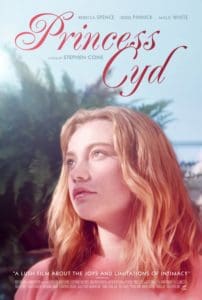
Release Date: November 3, 2017
Director: Stephen Cone
MPAA Rating: NR
Runtime: 96 minutes
Princess Cyd is all about light – its transformative abilities, its power to illuminate and purify. It graces just about every inch of the film in one way or another, and – though it may seem somewhat hokey, utilizing light as an instigator in a story of reawakening and coming of age – the way in which writer/director Stephen Cone executes his narrative enables him to achieve a warm-hearted earnestness that comes close to brushing up against sentimentality without ever fully embracing it.
The neutralizing power of light is employed at the outset as sunshine floods out the black backdrop, shrouding a 911 call that serves as a tragic piece of backstory for our main character, Cyd (Jessie Pinnick). Contained within that flood of sunshine is a sense of vitality, signaling what the sunlight will bring forth and how it’ll be utilized alongside Cyd, who essentially becomes an extension of that light and its properties as she visits with her novelist aunt, Miranda Ruth (Rebecca Spence), in Chicago.
Early on in her visiting stay, Cone marries Cyd’s presence with light, merging the two into an enlightening force of change in Miranda’s life. Both through the script, which mentions the spectacular light that fills the family home (specifically the light that enters Cyd’s late mother’s room), and Zoe White’s cinematography, in which frame after frame shimmers with sun. The melding of influences – Cyd and light – is effectively conveyed early on as Cyd wanders out into the backyard garden with brightness bathing flowers and a cut back to the face of Miranda, speckled in the sunlight of breached foliage, as happiness begins to manipulate her features revealing the impact Cyd will have from here on out.

Through Cyd’s interpretations of the characters in Miranda’s work, it becomes clear that Miranda has slowly been withdrawing from life in one way or another, becoming more and more sheltered from the possibilities of disappointment and pain – but also happiness and joy to a certain extent. Even her newest novel revolves around a woman who develops a heightened version of photophobia that affects her relationships but, through the reintroduction of Cyd’s youthful energy and carefree disposition, a certain youthful spontaneity is reignited in Miranda.
It all comes back to (sun)light as it pulls double-duty in usage, simultaneously employed on the surface as an affecting harbinger of change and within the subtext of Miranda’s works. Princess Cyd does teeter on a tightrope of between cliché and originality by positing familiar themes within familiar frameworks as the younger generation enlightens the older generation and, occasionally, vice versa. Yet Cone is able to alter these themes, and the way in which he presents them – just enough to render them distinct – and the success of this is predicated upon Cone’s sincerity, in and of the material and the way in which he presents it.
Another benefit to the film would be the naturalistic performances from Jessie Pinnick and Rebecca Spence, both of whom set the tone early on while faultlessly preserving that natural atmosphere throughout. Their respective turns, coupled with Cone’s screenplay, are a big reason the film is able to establish an unwavering genuineness. Each actor is presented with a healthy range of emotions and moods, and neither one stumbles, not in the slightest.

Princess Cyd is, no doubt, a message film. There is no denying that the two central characters end up learning a plethora of life lessons from each other, yet Cone’s message never has the feel of heavy-handedness, albeit direct and straightforward. Again, it works because of how he handles the subject matter with sincerity and an earnestness that illustrates his assuredness and commitment to the material. Even when some of the film’s conflicts and revelations are awkwardly introduced, it is his concentrated sincerity that ultimately wins out.
Another positive aspect of the film would be how the film represents its main character, Cyd (as well as the supporting characters), in that her sexuality is never applied in a way to initiate drama and/or conflict. She simply exists as a pansexual. There are no weighted conversations between her and her aunt; no conflict is born out of her sexuality; the initial discussion that brings it to light is nothing more than a nonchalant statement dropped in the midst of small talk. The only thing that accompanies her sexuality is a burgeoning confidence in that sexuality and herself.






